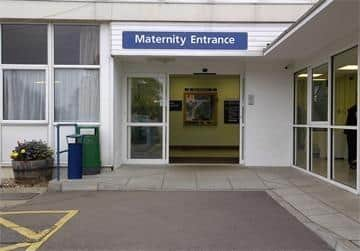'Babies at risk of harm' - Banbury campaigners lament critical new report on downgraded Horton maternity unit
and live on Freeview channel 276
The Care Quality Commission (CQC) has rated maternity services at Horton General Hospital as ‘requires improvement’, following an inspection in October.
Inspectors found staff at the downgraded Horton midwife unit were not always recognising and reporting incidents and ‘near misses’ when they should have been; safety equipment was not always checked regularly and people using the service were not always risk assessed, the CQC inspectors said. The birthing pool was not always decontaminated correctly after use.
Advertisement
Advertisement
The full obstetric (consultant-led) maternity service was moved to Oxford without prior public consultation in 2016, leaving a midwife-only unit which requires a 24-hour ambulance to be outside in case a mother or baby having difficulty needs to be transferred to the JR Hospital.


The CQC report said the service requires improvement for how safe and well-led it is. The inspection did not rate how effective, caring, and responsive the service was.
This is the first time maternity services at Horton have been rated as a standalone, core service. Previously, maternity and gynaecology were inspected and rated together.
The ratings for the Horton overall have also been downgraded from good to requires improvement, as have the areas of ‘safe’ and ‘well-led’. The overall rating for Oxford University Hospitals NHS Foundation Trust (OUH) remains ‘requires improvement’.
Advertisement
Advertisement
CQC spokeswoman Carolyn Jenkinson said of the Horton midwife unit: “We found... poor governance and ineffective systems and processes which meant women, people using the service and their babies could be put at risk of harm.


“We found examples of poor record-keeping and people... weren’t always being risk assessed. The midwife-led unit used a national tool to assess whether someone giving birth was at risk of deteriorating, but staff weren’t always completing these records and leaders didn’t audit them.
"This lack of oversight meant leaders weren’t always able to identify issues or make improvements when issues were found.
“It was also concerning that safety equipment wasn’t always checked regularly, which meant some out-of-date equipment and products might be used on people. We found a blood giving set which had expired several months before the inspection and an ambulance transfer bag with expired items inside. This could put women, people using the service and their babies at risk of harm.
Advertisement
Advertisement
“Staff weren’t always recognising and reporting incidents and ‘near misses’ when they should have been. Incidents which should have been reported included when people gave birth at the midwife-led unit when they had planned to give birth at the hospital with consultants. These incidents could have been escalated so staff can learn lessons for the future.


“We’ll be monitoring the trust closely, including through future inspections, to make sure women, people using the services and their babies are safe.”
Inspectors also found:
- The service wasn’t always ensuring a second midwife was available during later stages of birth
- Although staff had access to policies and procedures, some policies were hard to follow and hadn’t been updated. This meant some people might not be directed to the right place to manage issues
- Staff didn’t always follow trust policy to clean the birthing pool and ensure it was decontaminated correctly after use.
Milica Redfearn, Director of Midwifery at OUH, said: “We are disappointed by this result but we always welcome feedback on ways to improve our services and we will work with staff, women, and birthing people to make the improvements suggested. We have a great team at the Horton midwifery-led unit as the inspectors found."


Prof Meghana Pandit, OUH CEO, said: “As a learning organisation we will improve services along the lines highlighted in the report, although I am disappointed for the staff who have been working so hard to make improvements already.
Advertisement
Advertisement
“I want to be very clear that our commitment to the Horton is unwavering and although this new rating is a setback, we are immensely proud of our local hospital, the services it provides and our wonderful staff.
"Our plans for the Horton as a modern district general hospital providing urgent and local care to the people of Banbury and surrounding areas are set out in our Clinical Strategy.”
However Keep the Horton General campaign said the report was a vindication of Banbury’s determination to fight for the return of an obstetric service.
"Things have gone downhill since the 2016 downgrade as we predicted they would. Mothers have been reporting nightmarish tales of their experience of giving birth in Oxford which everyone knows is too far to expect pregnant mums or those in labour to travel for ante-natal consultant supervision and delivery,” said chairman Keith Strangwood.
Advertisement
Advertisement
“We had a full consultant service here, with theatres for elective and emergency Caesareans and a special care baby unit for premature and poorly babies. These were services any population as big as ours should have.
"Instead we were left with a midwife-only unit, delivering 134 babies a year - down from 1,700-1,800. And the population of Banburyshire has risen sharply. The maternity building has been allowed to decay and is now not fit for purpose.
"We have continued to campaign and support midwives who are hard-pressed and stressed. We know management are struggling to keep services at a good level. The Horton is being reduced gradually to a day-case hospital.”
Banbury MP Victoria Prentis called the report ‘extremely disappointing’.
Advertisement
Advertisement
“The CQC recognises the unit has a safe staffing level and there is good leadership in place. It makes some positive observations about the range of maternity services at the Horton and work done to tackle health inequalities in the community. It is clear important improvements need to be made to processes, practices and procedures. I have been told some action has already taken place. I will be meeting the CQC to discuss their findings in further detail,” she said.